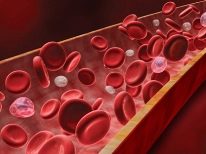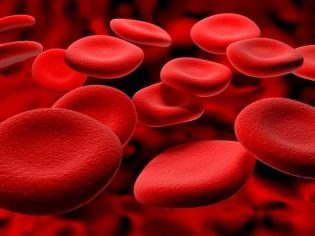Erythrocytes in the urine during pregnancy and the causes of blood in the urine
Bearing a baby is a rather difficult and crucial period. Any maternal pathology at this stage can lead to adverse consequences for the fetus. The appearance of red blood cells in the urine is a prerequisite for urgent treatment to the doctor.
Why do red blood cells appear in the urine?
Normally, there is almost no red blood cells in the urinary sediment. Only a small concentration of them is allowed. These blood cells appear in the urinary sediment as a result of various pathologies. Most often these are diseases of the kidneys and urinary organs.
If red blood cells are elevated in the urine, the doctors call this condition erythrocyturia or hematuria. It is extremely dysfunctional. In future moms - even dangerous. The development of this pathological state is often accompanied by the formation of pathologies in the fetus.
Erythrocyturia may be of varying severity. It depends on how many red blood cells appear in the urinary sediment.
If this number is insignificant, then the doctors call this condition micro hematuria. A large accumulation of red blood cells leads to the development of a more dangerous condition - gross hematuria. In this case, it can be seen and "naked" look.
Red blood cells are red blood cells. They are necessary for the body to transfer dissolved oxygen to all internal organs. A baby growing in the maternal tummy requires a lot of nutrients for its development and growth, which the red blood cells carry. The overall blood flow system leads to the fact that the pathology of the mother can occur in her baby.
During the carrying of the baby, the need to provide oxygen increases many times over. This feature is largely due to the daily changing physiology and anatomy of the fetus. Insufficient intake of substances due to various pathologies of the mother lead to severe hypoxia (oxygen starvation) of the baby.
Causes of
Doctors distinguish several clinical variants of hematuria. True is the pathology that occurs in the distal (distant) parts of the kidneys and the initial part of the urinary tract. Red blood cells that appear in the urinary sediment, experts are already called "treated."
If the pathological condition was caused by pathologies that have arisen in the lower parts of the urinary tract, but it is called unreal hematuria. The red blood cells that appear in the urinary sediment are called “fresh” or untreated kidneys.
A variety of pathologies can lead to an increase in the urine of erythrocytes. Quite often lead to this state chronic glomerulonephritis and pyelonephritis. These pathologies arise from kidney damage. They occur in women quite often. As a rule, these diseases can occur even before pregnancy.
Inflammatory processes in the urinary tract are also quite common causes leading to the appearance of large numbers of red blood cells in the urinary sediment. Damage to these anatomical structures is most often caused by various bacterial infections.
Also, traumatic damage to the urinary tract can also lead to the development of inflammation. In this case, microinvasive intervention of urologists may be required.
Chronic cystitis, accompanied by frequent exacerbations, can also cause a large number of red blood cells in the urine. This pathology is accompanied by multiple unfavorable symptoms. In an ill woman, urination becomes more frequent, the portions of urine become small in volume. In the lower abdomen, a "pulling" pain syndrome occurs.
Urolithiasis, accompanied by permanent damage to the mucous membrane of the urethra, can lead to multiple lesions. This is manifested by the fact that red blood cells appear in the urinary sediment. Also with this pathology, the indicators of the general analysis of urine change. Oxalates or urates may appear in it, and during exacerbation, leukocytes may appear.
The appearance of erythrocytes in the urinary sediment is caused not only by the pathology of the kidneys or urinary system. Diseases of the reproductive organs are frequent pathologies that contribute to the appearance of erythrocyturia in pregnant women. Erosion of the cervix is accompanied by trauma to the inner epithelial lining. This condition leads to the frequent development of microbleeds, which are manifested by the appearance of red blood cells in the urinary sediment.
Colpitis and vaginitis are quite common diseases of the genital organs, which can lead to the appearance of red blood cells in the urinary sediment. Perhaps this is mainly due to incorrect collection of urine. In order to prevent this, Doctors recommend to cover the vaginal opening with a cotton swab when collecting the test.
Various sexually transmitted diseases, occurring with damage to the organs of the urinary and reproductive systems, also cause an increase in urine leukocytes. To identify these pathologies is possible only when referring to a doctor.
To establish the diagnosis requires a range of different laboratory tests. It is important to note that if such a disease has been established, then both partners should be treated at once.
In late pregnancy red blood cells often appear in the urine. Usually this situation occurs in many expectant mothers. It is explained by the growing pressure of the uterus on the bladder and urinary tract. This leads to compression of these organs and pronounced stagnation of fluid, which is manifested by erythrocyturia.
Long-term use of certain drugs - Another reason for the appearance of red blood cells in the urinary sediment. This situation manifests itself in both early and late gestation. Quite often, long-term hormone therapy leads to the development of this type of pathology.
Diseases of internal organs may also cause the development of erythrocyturia during pregnancy. Women with diabetes, even before conception, have a significant risk of high red blood cell levels in the urine. The uncontrolled course of this pathology is very dangerous for the intrauterine development of the baby..
Systemic metabolic disorders and pathologies may also cause hematuria. One of these diseases is gout, accompanied by a high concentration of urea in the blood. During the exacerbation of this pathology in a pregnant woman, red blood cells in the urine can be elevated.
Erythrocyturia may also cause various adverse effects of the environment. These include prolonged debilitating stress. The depletion of the nervous and immune systems leads to the exacerbation of multiple problems in the work of the urological tract and other internal organs. Ultimately, this can lead to the appearance of leukocytes and red blood cells in the urine.
In some cases, certain types of anemia can cause blood to appear in the urine. Systemic and rheumatological diseases are also trigger factors for the development of erythrocyturia. Systemic lupus erythematosus - a pathology that occurs with kidney damage. Without adequate treatment in this case can not do. When prescribing therapy, doctors always take into account the possible risk of drugs for the fetus.
In some cases, erythrocyturia is an extremely unfavorable symptom and indicates a threat to the life of the baby. In such situations, as a rule, it is not the separate red blood cells that appear in the urine, but blood. This can occur at the beginning of uterine bleeding. In the later stages, beginning placental abruption can occur. This means a strong threat to the fetus.
How to determine?
To detect the initial manifestations of hematuria is a rather difficult task. With single red blood cells, this is almost impossible to do. To detect a small hematuria, a general urine analysis is required. You can do this research both in a usual female consultation and in a private laboratory.
The duration of this analysis is usually short The readiness of the result is possible after a few hours or by the end of the first day from the moment the material is delivered Collect urine for analysis only in a clean, dry container with a screw cap.
Urinalysis is a basic study required to detect hematuria. Normally, in the urinary sediment in women should contain no more than 1 red blood cell in the studied field of view. During pregnancy, this figure remains the same. Any deviations from normal values are already considered pathological.
With an increase in the urinary sediment level of red blood cells to five units, experts say the presence of micro hematuria. Higher rates already indicate a manifestation of gross hematuria. Both of these pathological conditions require mandatory additional diagnostics.
To do this, doctors, as a rule, prescribe to pass the material to conduct research on Nechiporenko. This test is more accurate in terms of calculation and helps to accurately determine the degree of severity of violations that have occurred. Both the therapist and the obstetrician-gynecologist who monitors a woman during pregnancy can prescribe such an analysis.
What to do with the increase of red blood cells in the urine?
A high level of red blood cells in the blood is a must for referring the future mother to the urologist. This is necessary to exclude kidney and urinary tract diseases, which most often lead to the appearance of this symptom. Also, a woman is necessarily examined and advised by a therapist.
One analysis is not yet the basis for diagnosis.. The appearance of red blood cells in the urine requires mandatory retesting. For this purpose, a repeated general urine analysis is appointed, and if necessary, other laboratory tests, including the Nechiporenko study.
After the diagnosis has been established, the doctors will form a whole complex of drug therapy. If the cause of the pathology has become a bacterial infection, the prescription of antibacterial drugs will be required. Antibiotics are still undesirable to prescribe in the first trimester of pregnancy, when the fetus still has all the internal organs and systems.
Traumatic pathologies are treated by urologists with the use of micro-invasive technologies. The resulting attack of urolithiasis with the discharge of the stone along the urethra requires urgent hospitalization of the pregnant woman in the hospital. To relieve a painful attack will require the appointment of painkillers and antispasmodics.
Urinary tract infections, occurring in a moderate degree of activity, may require only the appointment of uroseptics. Preparations of choice for pregnant women - products containing herbal ingredients. Medicinal herbs and berries are applied by exchange intake and normalize indicators of urine for a rather short period of time.
As medicinal decoctions, you can use the cranberry leaf and berries, cranberries, as well as ready-made pharmaceutical charges. These multi-component tools include, for example, "Kanefron". His course use allows you to normalize urination and reduce red blood cells in the urine.
If the cause of the appearance in the urine is any disease of the internal organs, its treatment will be required. With the onset of bleeding from the uterine vessels, a mandatory hospitalization of the expectant mother to the hospital is required due to the strong threat to the life of the mother and baby. In this case, emergency therapy is carried out by obstetrician-gynecologists.
Of course, follow the red blood cells in the urine should be required. For this, the future mom should only regularly visit the antenatal clinic and her obstetrician-gynecologist.
Negative dynamics and an increase in the number of red blood cells in the urinary sediment can be an indication for ultrasound.
In the next video you will find an interesting webinar on the above topic.


























